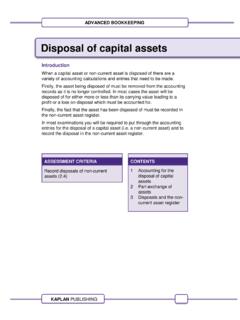Transcription of Performance measurement techniques - Kaplan
1 Performance measurement techniques Chapter learning objectives Upon completion of this chapter you will be able to: discuss the purpose of mission statements and their role in Performance measurement discuss the purpose of strategic and operational and tactical objectives and their role in Performance measurement discuss the impact of economic and market conditions on Performance measurement explain the impact of government regulation on Performance measurement discuss the relationship between short term and long term Performance discuss and calculate measures of financial Performance (profitability, liquidity, activity and gearing) and non financial measures discuss the importance of non financial Performance measure Perspectives of the balanced scorecard discuss the advantages and limitations of the balanced scorecard describe Performance indicators for financial success, customer satisfaction, process efficiency and growth discuss and establish critical success factors and key Performance indicators and their link to objectives and mission statements establish critical success factors and key Performance indicators in a specific situation discuss the role of benchmarking in Performance measurement525chapter16 Economy, efficiency and effectiveness discuss the meaning of each of the efficiency, capacity and activity ratios calculate the efficiency.
2 Capacity and activity ratios in a specific situation Resource utilisation describe measures of Performance utilisation in service and manufacturing environments establish measures of resource utilisation in a specific situation distinguish Performance measurement issues in service and manufacturing industries in relation to measurement techniques526 Kaplan PUBLISHING526 Kaplan PUBLISHING 1 Introduction Performance measurement is the monitoring of budgets or targets against actual results to establish how well the business and it's employees are functioning as a whole and as individuals. Performance measurements can relate to short term objectives ( cost control) or longer term measures ( customer satisfaction). Objectives and goals of a business will vary depending on the type of business that is being operated. For example: What these businesses have in common is that they will have long term (strategic) goals or objectives.
3 These long term goals will be broken down into tactical and operational targets which will need to be monitored. To be able to do this they will identify critical success factors and key Performance indicators to monitor to ensure targets are met. A profit seeking companys overall goal will be to maximise their shareholders wealth so they will want to monitor profitability (based on increasing sales and reducing costs) and growth or market share compared to competitors. A not for profit organisation, for example a government department, will want to provide the best service possible for the lowest cost so that the residents being cared for achieve value for money from the taxes they mission statement and the corporate plan You will recall that a mission statement, as discussed in chapter 1, should describe the overall goal of the organisation and that objectives may be developed at strategic, operational and tactical levels in order to allow an organisation to measure progress towards the overall goal.
4 The different elements of the mission statement can be used as a guide for producing Performance measures for the business. Purpose is the business meeting it's main aims? Maximisation of shareholder wealth? Maintaining customer satisfaction? Producing innovative products/services?chapter 16 Kaplan PUBLISHING527 Suitable Performance measures need to be set to monitor the achievement of each objective. Measures will differ according to the type of objective. As seen in chapter 1 there are three different planning levels: Suitable measures may include: As you can see there are short term objectives and long term goals and objectives. The short term objectives will enable the businesses to monitor progression towards the ultimate long term goal and to enable Performance of employees to be measured along the way. Suitable Performance measures therefore need to be set to monitor the achievement of each objective.
5 Strategy is the business providing the products and services it planned to? Is the product or service being provided in the manner it intended? Policies and culture are the staff behaving in the manner expected of them? Is customer service at an appropriate level? Values are the core principles of the business being maintained and not compromised? Is staff morale being maintained at a suitable level? What is the level of staff turnover? Strategic or corporate planning often the responsibility of the senior management and will be measured by indicators that reflect the Performance of the whole organisation over the longer term. Tactical often the responsibility of middle management and measures may be used that summarise the Performance of a department or division, breaking the strategic plan into manageable chunks for each business unit or department Operational often concerned with the day to day running of the organisation and are often physical measures turning the strategic and tactical plans into the day to day running of the business.
6 Strategic measurement of the overall profitability of the business and/or the return made on investing surplus cash. Return on investment (ROI), return on sales produced monthly Tactical comparison of the actual costs and revenues with the budgeted costs and revenues for each business unit or department. Actual profit compared to budget produced monthly Operational measurement of day to day targets such as meeting production requirements, meeting sales targets and reducing wastage. Quantity of rejects, number of customer complaints produced dailyPerformance measurement techniques528 Kaplan PUBLISHING2 External factors affecting Performance measurement External factors may be an important influence on an organisation s ability to achieve objectives. In particular market conditions and government policy will be outside of the control of the organisation s management and will need to be carefully monitored to ensure forecasts remain accurate.
7 Economic and market conditions Any Performance measure that is used by a business will need to be flexible to allow for peaks and troughs in economic and market conditions that are beyond the control of the business or the specific employee or manager. The actions of competitors must also be considered. For example, demand may decrease if a competitor reduces its prices or launches a successful advertising campaign. Government regulation The government can have a direct effect on the workings of a private sector organisation by introducing regulations or by having departments that monitor business activity such as: Other regulations that the government can enforce include: If a private sector organisation is affected by government regulation then the Performance measures should take account of this externally imposed limitation a sales team target should not exceed a quota or exceed/undercut a price set by the government.
8 The Competition Act which prohibits anticompetitive agreements and any abuse of a dominant market position. The Office of Fair Trading who investigates any businesses suspecting of breaching the Competition Act. Taxation tax on alcohol and petrol with the intention of reducing consumption Subsides subsides given to firms providing training for employees Fines and quotas quotas or maximums are set to limit production and if exceeded fines are imposed. For example fishing quotas are set to prevent over fishing of the seas and if a trawler brings in too much then a fine is 16 Kaplan PUBLISHING529 Public Sector organisations are owned and controlled by the government (or local government). They aim to provide public services, often free at the point of delivery. Their purpose is to provide a quality service to the public, for example a state school, the provision of water and sewerage services, refuse collections.
9 The measurement of Performance is much harder for public sector organisation the standard of the service will be based on opinions or feelings and not necessarily fact. If we are trying to compare the Performance of a private organisation with that of a public organisation the differences in strategy need to be considered. This can be seen in the summarised table below showing the differences between a private school and a state school. Comparing strategy in private and public sector organisations Strategic featurePrivate school State schoolGeneral strategic goalCompetitivenessAchievement of missionGeneral financial goalsProfit growth market shareCost reduction efficiencyValuesInnovation creativity good will recognitionAccountability to public integrity fairnessDesired outcomeCustomer satisfactionCustomer satisfactionStakeholdersFee payersTaxpayers inspectors legislatorsBudget defined byCustomer demandLeadership legislators plannersKey Success FactorsGrowth rate earnings market share Uniqueness Advanced technology Best management practices Standardisation economies of scale Standardised technology3 Critical success factors Critical success factors (CSFs)
10 Are the essential areas of the business that must be performed well if the mission, objectives and goals of the business are to be achieved. CSFs act as a common point of reference to measure the success of the business. CSFs help everyone in the team to know exactly what they need to do to ensure the success of the business. This helps employees perform their own work in the right context and so pull together towards the same overall aims to achieve goal congruence. Performance measurement techniques530 Kaplan PUBLISHINGCSFs are related to the mission and goals of the business: measurement of CSFs is possible by the creation of key Performance indicators (KPIs). KPIs can be based on financial and non financial information. The mission focuses on the overall long term aims and what is ultimately to be achieved Objectives break down the mission into quantifiable goals CSFs are the essential areas that must be perfected to achieve the objectives and therefore the mission of the table below shows a number of Performance indicators grouped against CSFs.










